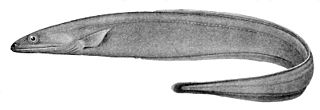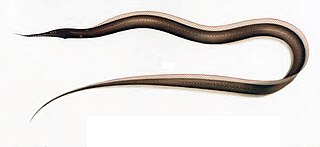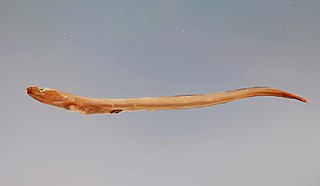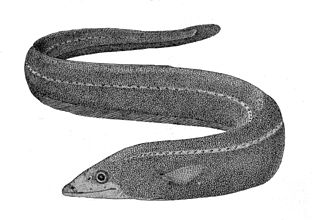
Cutthroat eels are a family, Synaphobranchidae, of eels, the only members of the suborder Synaphobranchoidei. They are found worldwide in temperate and tropical seas.

The grey cutthroat eel, Synaphobranchus affinis, is a cutthroat eel. It was originally described by Albert Günther in 1877. It lives a benthic lifestyle, inhabiting the continental slope and global deep waters including near Portugal, Canary Islands, Morocco, Japan, Australia, and others. It is a marine, deep water-dwelling eel which has been found at depths ranging from 300 to 2300 meters and at temperatures ranging from 3.3 - 11.3 °C. Males can grow to a length of up to 110 centimeters. It is primarily a scavenger, however it also actively hunts small fish and crustaceans.

Synaphobranchus is a genus of eels in the cutthroat eel family, Synaphobranchidae. It currently contains the following species:

Eels are ray-finned fish belonging to the order Anguilliformes, which consists of eight suborders, 20 families, 164 genera, and about 1000 species. Eels undergo considerable development from the early larval stage to the eventual adult stage and are usually predators.
The slope conger, also known as the black-fin conger, is an eel in the family Congridae. It was described by Charles Henry Gilbert in 1891, originally under the genus Ophisoma. It is a marine, deep water-dwelling eel which is known from the southeastern and eastern central Pacific Ocean, including Colombia, Ecuador, Costa Rica, Honduras, El Salvador, Mexico, Guatemala, Nicaragua, Panama, and Peru. It is known to dwell at a depth range of 380–740 metres, and inhabits substrates. Males can reach a maximum total length of 35 centimetres.

Ariosoma selenops is an eel in the family Congridae. It was described by Earl Desmond Reid in 1934. It is a marine, deep water-dwelling eel which is known from the northwestern, southwestern, and western central Atlantic Ocean, including Antigua and Barbuda, the Bahamas, Brazil, Dominica, the Dominican Republic, Canada, Haiti, Grenada, Guadeloupe, Martinique, Puerto Rico, Jamaica, Saint Vincent and the Grenadines, Saint Lucia, the United States, and Venezuela. It is known to dwell at a depth range of 348–549 metres.
The flapnose conger is an eel in the family Congridae. It was described by David G. Smith and Robert H. Kanazawa in 1977. It is a tropical, marine eel which is known from French Guiana, in the western central Atlantic Ocean. It is known to dwell at a depth of 210 metres.
The deepsea conger is an eel in the family Congridae. It was described by Peter Henry John Castle in 1960, originally under the genus Pseudoxenomystax. It is a marine, temperate water-dwelling eel which is known from the southwestern Pacific Ocean. It leads a benthic lifestyle and inhabits continental shelves and slopes. Males can reach a maximum total length of 100 centimetres.
The neighbor conger is an eel in the family Congridae. It was described by Samuel Garman in 1899, originally under the genus Uroconger. It is a marine, deep water-dwelling eel that is known from the southwestern and western central Atlantic Ocean, including the Bahamas, Brazil, Cuba, and Mexico. It dwells at a depth range of 101–503 metres (331–1,650 ft). Males can reach a maximum total length of 46.2 centimetres (18.2 in).

The large-toothed conger is an eel belonging to the family Congridae. It was described by Léon Vaillant in 1888, originally as a species of the genus Uroconger.
Congriscus maldivensis is an eel in the family Congridae. It was described by John Roxborough Norman in 1939, originally under the genus Conger. It is a marine, deep water-dwelling eel which is known from the Indo-Western Pacific, including Australia, Fiji, Madagascar, Maldives, New Caledonia, the Philippines, Vanuatu, and Wallis and Futuna. It dwells at a depth range of 354–820 metres (1,161–2,690 ft). It can reach a maximum standard length of 35.2 centimetres (13.9 in).
Nessorhamphus danae, the blackbelly spoonbill eel or Dana duckbill eel, is an eel in the family Derichthyidae. It was described by Johannes Schmidt in 1931. It is a marine, deep water-dwelling eel which is known from throughout the Atlantic, Pacific, and Indian Oceans, including Australia, Brazil, Benin, Bangladesh, Cameroon, Cambodia, China, Ghana, Pakistan, Côte d'Ivoire, Guinea, India, Mozambique, Guinea-Bissau, Indonesia, Liberia, Malaysia, Kenya, Mauritania, Myanmar, Nigeria, Papua New Guinea, Senegal, Sierra Leone, the Philippines, Somalia, South Africa, Tanzania, Sri Lanka, Thailand, Togo, the Hawaiian Islands, USA; Yemen, and Vietnam. Males can reach a maximum total length of 30 centimetres (12 in).
The bridge duckbill eel is an eel in the family Nettastomatidae. It was described by Peter Henry John Castle and David G. Smith in 1981. It is a marine, deep water-dwelling eel which is known from the western Pacific Ocean, including New Caledonia, the Philippines, and Indonesia. It dwells at a depth range of 400–412 metres (1,312–1,352 ft). Females can reach a maximum total length of 43.1 centimetres (17.0 in).

Venefica tentaculata is an eel in the family Nettastomatidae. It was described by Samuel Garman in 1899. It is a marine, subtropical eel which is known from the eastern central and northwestern Pacific Ocean, including Mexico, Nicaragua, Japan, and the United States. It dwells at a depth range of 100 to 500 metres, but may dive even deeper. Males can reach a maximum total length of 90 centimetres (35 in).
The angry worm eel is an eel in the family Ophichthidae. It was described by Peter Henry John Castle and John E. McCosker in 1999. It is a tropical, marine eel which is known from the eastern Indian and western central Pacific Ocean, including India, Indonesia, the Straits of Malacca, northern Australia, and the Philippines. It is known to inhabit shallow, turbid estuaries, and to a lesser extent the deeper water over soft substrates. Males can reach a maximum total length of 29.6 centimetres.

The blackpored eel is an eel in the family Ophichthidae. It was described by Robert H. Kanazawa in 1963. It is a tropical, marine eel which is known from the western central Atlantic Ocean, including Florida, USA; the Bahamas, and Mexico. It dwells at a depth range of 51–460 meters. While the adults inhabit deep water, the larvae are laid inshore. Males can reach a maximum total length of 70 centimeters.

The short-tooth sawpalate is an eel in the family Serrivomeridae. It was described by Johannes Schmidt in 1916 in its larval form, originally under the genus Leptocephalus, and later as a subspecies of Serrivomer sector by Roule & Bertin in 1929. It is a marine, deep water-dwelling eel which is known from the eastern central and western central Atlantic Ocean, including the Strait of Gibraltar, Cape Verde, the United States, the Bahamas and Bermuda, as well as the Strait of Gibraltar, Cape Verde, Canada and the United States. It dwells at a depth range of 150 to 6,000 metres. Males can reach a maximum total length of 65 centimetres (26 in).

The shortdorsal cutthroat eel is an eel in the family Synaphobranchidae. It was described by Albert Günther in 1887. It is a marine, deep water-dwelling eel which is known from the Indo-Pacific and western central Atlantic Ocean, including Zanzibar, Maldives, Australia, Japan, Suriname, and the Gulf of Mexico. It dwells at a depth range of 900 to 3,000 metres, most often between 1,000 to 2,500 metres, and leads a benthic lifestyle, inhabiting the continental slope. Males can reach a maximum total length of 111 centimetres (44 in).
Synaphobranchus dolichorhynchus is an eel in the family Synaphobranchidae. It was described by Einar Hagbart Martin Lea in 1913, originally under the genus Leptocephalus. It is a marine, subtropical eel which is known solely from larval specimens discovered in the northern Atlantic Ocean. It is known to dwell at a depth range of 100 to 150 metres.

The Kaup's arrowtooth eel is an eel in the family Synaphobranchidae. It was described by James Yate Johnson in 1862. It is a marine, deep water-dwelling eel which is known from the Indo-Western Pacific and eastern and western Atlantic Ocean, including the Faroe Islands, Iceland, Cape Verde, the Western Sahara, Nigeria, Namibia, South Africa, Greenland, France, Saint Pierre and Miquelon, the United Kingdom, Ireland, the Philippines, Portugal, Spain, the Bahamas, Brazil, Canada, Cuba, Japan, Australia, Mauritania, Morocco, and Hawaii. It dwells at a depth range of 120 to 4,800 metres, most often between 400 and 2,200 metres, and inhabits the upper abyssal zone on the continental slope. It is intolerant of the temperatures of higher waters. Males can reach a maximum total length of 100 centimetres (39 in).










